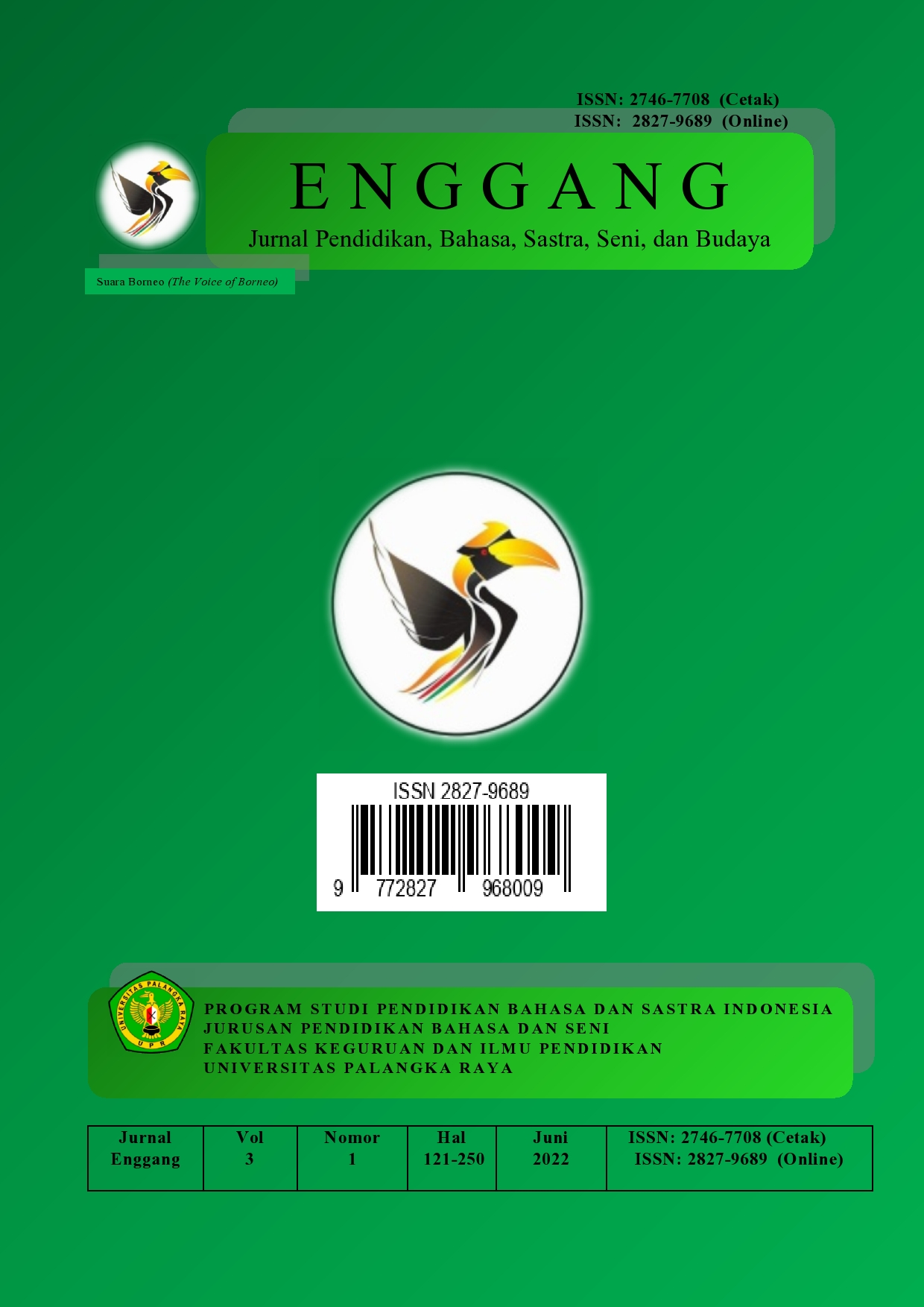THE EFFECT OF USING KAHOOT IN WRITING FUNCTIONAL TEXT FOR SENIOR HIGH SCHOOL STUDENTS
DOI:
https://doi.org/10.37304/enggang.v3i2.8999Abstract
Based on the observation at a private senior high school in Batam, the students were not fully engaged with the class. Some of them were busy with their activity, resulting in not paying attention in class. The teaching media was boring too. Thus, the authors implemented Kahoot as game-based learning media to engage students in the class as well as to improve the students’ writing skills in functional text. Classroom Action Research (CAR) method was implemented in the study. Thirty-eight students from class X-10 from a private senior high school in Batam participated in this study. A pre-test, post-test, and rubric scores were used to evaluate the student’s writing skills in functional text. The authors also shared the questionnaire with the students to measure their engagement after the implementation. After the Kahoot implementation, the students’ writing has notably gotten better, which has improved from 65,30 (pre-test) to 72,48 (post-test in cycle 1) and 88,82 (post-test in cycle 2). Equally, the students showed a positive attitude toward their engagement in class, whether in affective, behavioural, or cognitive engagement.
Downloads
References
Adipat, S., Laksana, K., Busayanon, K., Asawasowan, A., & Adipat, B. (2021). Engaging Students in the Learning Process with Game-Based Learning : The Fundamental Concepts. International Journal of Technology, 4(3), 542–552. https://doi.org/https://doi.org/10.46328/ijte.169
Ahmed, A. A. A., Sayed, B. T., Wekke, I. S., Widodo, M., Rostikawati, D., Ali, M. H., Hussein, H. A. A., & Azizian, M. (2022). An Empirical Study on the Effects of Using Kahoot as a Game-Based Learning Tool on EFL Learners ’ Vocabulary Recall and Retention. Education Research International. https://doi.org/https://doi.org/10.1155/2022/9739147
Al-hadithy, T., & Ali, S. (2018). GAMIFICATION IN LEARNING ENGLISH FOR ACADEMIC PURPOSES: DESIGNING ASSESSMENT FOR LEARNING USING KAHOOT WITH UAE UNDERGRADUATE LAW STUDENTS. 110th IASTEM International Conference, March, 36–40. https://doi.org/http://iraj.doionline.org/dx/IJMAS-IRAJ-DOIONLINE-12406
Al Mamun, M. A., & Lawrie, G. (2023). Student-Content Interactions: Exploring Behavioural Engagement with Self-Regulated Inquiry-Based Online Learning Modules. Smart Learning Environments, 10(1), 1–31. https://doi.org/10.1186/s40561-022-00221-x
Amalia, S. D., Santos, R. F., Dewi, E. Y., & Ramadani, L. G. (2022). Reinforcing Students’ Short Functional Text Writing Skill Through Mind Mapping Technique. Jurnal Penelitian Humaniora, 23(1), 35–45. https://doi.org/https://doi.org/10.23917/humaniora.v23i1.19137
Ardi, P., & Rianita, E. (2022). Leveraging Gamification Into Efl Grammar Class To Boost Student Engagement. Teaching English with Technology, 22(2), 90–114. http://cejsh.icm.edu.pl/cejsh/element/bwmeta1.element.ojs-issn-1642-1027-year-2022-volume-22-issue-2-article-de768fbb-a243-31ef-9481-fcd02ba62efd
Arini, Y., & Sulistyarini, I. K. A. (2021). Improving Critical Reading Ability , Learning Autonomy , and Learning Participation through Kahoot ! Application. Leksema (Jurnal Bahasa Dan Sastra), 6(1). https://doi.org/10.22515/ljbs.v6i1.3477
Barlow, A., Brown, S., Lutz, B., Pitterson, N., Hunsu, N., & Adesope, O. (2020). Development of The Student Course Cognitive Engagement Instrument (SCCEI) for College Engineering Courses. International Journal of STEM Education, 7(1). https://doi.org/10.1186/s40594-020-00220-9
Ben-Eliyahu, A., Moore, D., Dorph, R., & Schunn, C. D. (2018). Investigating the multidimensionality of engagement: Affective, behavioral, and cognitive engagement across science activities and contexts. Contemporary Educational Psychology, 53(January), 87–105. https://doi.org/10.1016/j.cedpsych.2018.01.002
Bicen, H., & Kocakoyun, S. (2018). Perceptions of Students for Gamification Approach : Kahoot as a Case Study. International Journal of Emerging Technologies in Learning (IJET), 13(2), 72–93. https://doi.org/https://doi.org/10.3991/ijet.v13i02.7467
Cabrera-Solano, P. (2022). Game-Based Learning in Higher Education: The Pedagogical Effect of Genially Games in English as a Foreign Language Instruction. International Journal of Educational Methodology, 8(4), 719–729. https://doi.org/https://doi.org/10.12973/ijem.8.4.719
Daher, W., Sabbah, K., & Abuzant, M. (2021). Affective engagement of higher education students in an online course. Emerging Science Journal, 5(4), 545–558. https://doi.org/http://dx.doi.org/10.28991/esj-2021-01296 ©
Fajri, S., & Lestari, W. (2022). IMPLEMENTASI KAHOOT BERBASIS DIGITAL GAME BASED EVALUATION PADA. Jurnal Seni Tari, 11(2), 147–153. https://doi.org/https://doi.org/10.24114/gjst.v11i2.39165
Ghazy, A., & Wajdi, M. (2021). The use of game-based learning in English class. Journal of Applied Studies in Language, 5(1), 67–78. https://doi.org/https://dx.doi.org/10.31940/jasl.v5i1.2400
Hart, S. R., Stewart, K., & Jimerson, S. R. (2011). The Student Engagement in Schools Questionnaire ( SESQ ) and the Teacher Engagement Report Form-New ( TERF-N ): Examining the Preliminary Evidence. Contemporary School Psychology, 15, 67–79. https://doi.org/https://doi.org/10.1007/BF03340964
Hartin, T., & Diamond, A. (2022). Understanding Game-Based Learning. Study.Com. https://study.com/learn/lesson/game-based-learning-elements-examples.html#:~:text=What are examples of game,students with spelling and vocabulary
Heni, V., Sudarsono, S., & Regina, R. (2019). Using Kahoot To Increase Students’ Engagement and Active Learning: a Game Based Technology To Senior High School Student. Proceedings International Conference on Teaching and Education (ICoTE), 2(2), 236. https://doi.org/http://dx.doi.org/10.26418/icote.v2i1.33949
Husin, M. Z. M., & Azmuddin, R. A. (2022). Learner Engagement in Using Kahoot! within a University English Proficiency Course. Educational Process: International Journal, 11(2), 167–180. https://doi.org/10.22521/edupij.2022.112.9
Jalaludin. (2021). Penelitian Tindakan Kelas (Prinsip dan Praktik Instrumen Pengumpulan Data). Jambi: Pustaka Media Guru.
Kemmis, S., & McTaggart, R. (1988). The Action Research Planner. Deakin University.
Li, S. (2022). Measuring Cognitive Engagement: An Overview of Measurement Instruments and Techniques. International Journal of Psychology and Educational Studies, 8(3), 63–76. https://doi.org/10.52380/ijpes.2021.8.3.239
Licorish, S. A., Owen, H. E., Daniel, B., & George, J. L. (2018). Students’ perception of Kahoot!’s influence on teaching and learning. Research and Practice in Technology Enhanced Learning, 13(1). https://doi.org/10.1186/s41039-018-0078-8
Mahbubah, L., & Anam, S. (2022). Students’ perceptions of the implementation of Kahoot! in English language teaching. Lingua Scientia, 29(1), 23–32. https://doi.org/https://doi.org/10.23887/ls.v29i1
Makhdum, N., Faisal, A., & Sandhu, H. R. (2023). Impact Of Kahoot ! On Students ’ Engagement And Learning Outcome At The Elementary Level In Pakistan : Their Perception Towards Kahoot ! Assessment. Journal of Positive School Psychology, 7(1), 64–78.
Misnawati, M., Poerwadi, P., Veniaty, S., Nurachmana, A., & Cuesdeyeni, P. (2022). The Indonesian Language Learning Based on Personal Design in Improving the Language Skills for Elementary School Students. MULTICULTURAL EDUCATION, 8(02), 31-39.
Muliya, M. (2022). Penerapan Media Quizizz Dalam Meningkatkan Hasil Belajar Siswa Pada Mata Pelajaran Bahasa Indonesia Kelas X Busana 2. ENGGANG: Jurnal Pendidikan, Bahasa, Sastra, Seni, dan Budaya, 3(1), 65-78.
Mufarikha, M., & Darihastining, S. (2022, November). Peningkatan Kemampuan Menyimak Cerita Rakyat Pada Siswa Kelas V MI Ghozaliyah Melalui Media Audio. In PROSIDING SEMINAR NASIONAL PENDIDIKAN, BAHASA, SASTRA, SENI, DAN BUDAYA (Vol. 1, No. 2, pp. 30-53).
Muhammad, Y. M. (2018). Implementation of Kahoot Application to Improving of Interest of Civic Education Learning (Experimental Research in Class XI of SMA Negeri 1 Garut). Journal Civics & Social Studies, 2(1), 75–92. https://doi.org/https://doi.org/10.31980/2655-7304.v2i1.399
Nkhoma, C., Nkhoma, M., Thomas, S., Tu, L. K., & Le, N. Q. (2018). Gamifying a Flipped First Year Accounting Classroom Using Kahoot! International Journal of Information System and Engineering, 6(2), 93–115. https://doi.org/10.24924/ijise/2018.11/v6.iss2/93.115
Nugroho, D. S. (2021). Using Kahoot ! Improving seventh-graders ’ reading comprehension skills of SMPN 2 Tegalrejo. Journal of English Language and Pedagogy, IV(1), 89–95. https://doi.org/https://doi.org/10.36597/jelp.v4i1.10997
Nurlaela, & Nawir, S. M. (2020). The Implementation of Kahoot in Improving Students ’ Tenses Understanding in Higher Education. International Journal for Educational and Vocational Studies, 2(11), 908–913. https://doi.org/https://doi.org/10.29103/ijevs.v2i11.3004
Rahmatullah, A. S., & Ghufron, S. (2021). The Effectiveness Of'facebook'as Indonesian Language Learning Media For Elementary School Student: Distance Learning Solutions In The Era Of The Covid-19 Pandemic. MULTICULTURAL EDUCATION, 7(04), 27-37.
Rinto Alexandro, M. M., Misnawati, M. P., & Wahidin, M. P. (2021). Profesi Keguruan (Menjadi Guru Profesional). Gue.
Putu, N., Resmayani, A., Nyoman, I., & Darma, T. (2019). Gamification : Using Kahoot ! to Make Students Love the Class from the Very Beginning. Linguistics and English Language Teaching Journsl, 7(June), 10–18. https://doi.org/https://doi.org/10.31764/leltj.v7i1.1649
Sholihah, T. M., & Lastariwati, B. (2020). Problem Based Learning to Increase Competence of Critical Thinking and Problem Solving. Journal of Education and Learning (EduLearn), 14(1), 148–154. https://doi.org/10.11591/edulearn.v14i1.13772
Utari, S. R. D. (2018). Meningkatkan Prestasi Belajar Siswa Materi Short Functional Text Tulis Slogan Pendek Lingkungan dengan Model Pembelajaran ENE (Example Non Example) Kelas VIII C SMPN 9 Madiun. Jurnal Edukasi Gemilang, 3(1), 71–76. https://doi.org/https://ejurnalkotamadiun.org/index.php/JEG/article/view/84
Villanueva, L., SInampaga, M. J. M., Flordeliza, M. S. M. R., Valera, M. J. K. C., & Ms, S. A. T. (2022). Kahoot ! App : An Interactive Tool to Enhance the English Participation of Grade 7 Students. American Journal of Arts and Human Science, 1(2). https://doi.org/https://journals.e-palli.com/home/index.php/ajahs/article/view/315
Wahyudi, E. E. C., & Pratiwi, T. L. (2023). The Use Of Ict In Enhancing Students ’ Interest In Learning English At Sman 16 Batam. ConCEPt - Conference on Community Engagement Project, 3(1), 959–975. https://doi.org/https://journal.uib.ac.id/index.php/concept/article/view/7606
Wang, A. I., & Tahir, R. (2020). The effect of using Kahoot! for learning – A literature review. Computers and Education, 149(May 2019), 103818. https://doi.org/10.1016/j.compedu.2020.103818
Warsihna, J., Ramdani, Z., & Prakoso, B. H. (2019). Using Kahoot to Improve Students’ Achievement and Critical Thinking in Undergraduate of Psychology Students. 16th International Conference on Cognition and Exploratory Learning in Digital Age (CELDA 2019), 144–150. https://doi.org/http://dx.doi.org/10.33965/celda2019_201911L018













